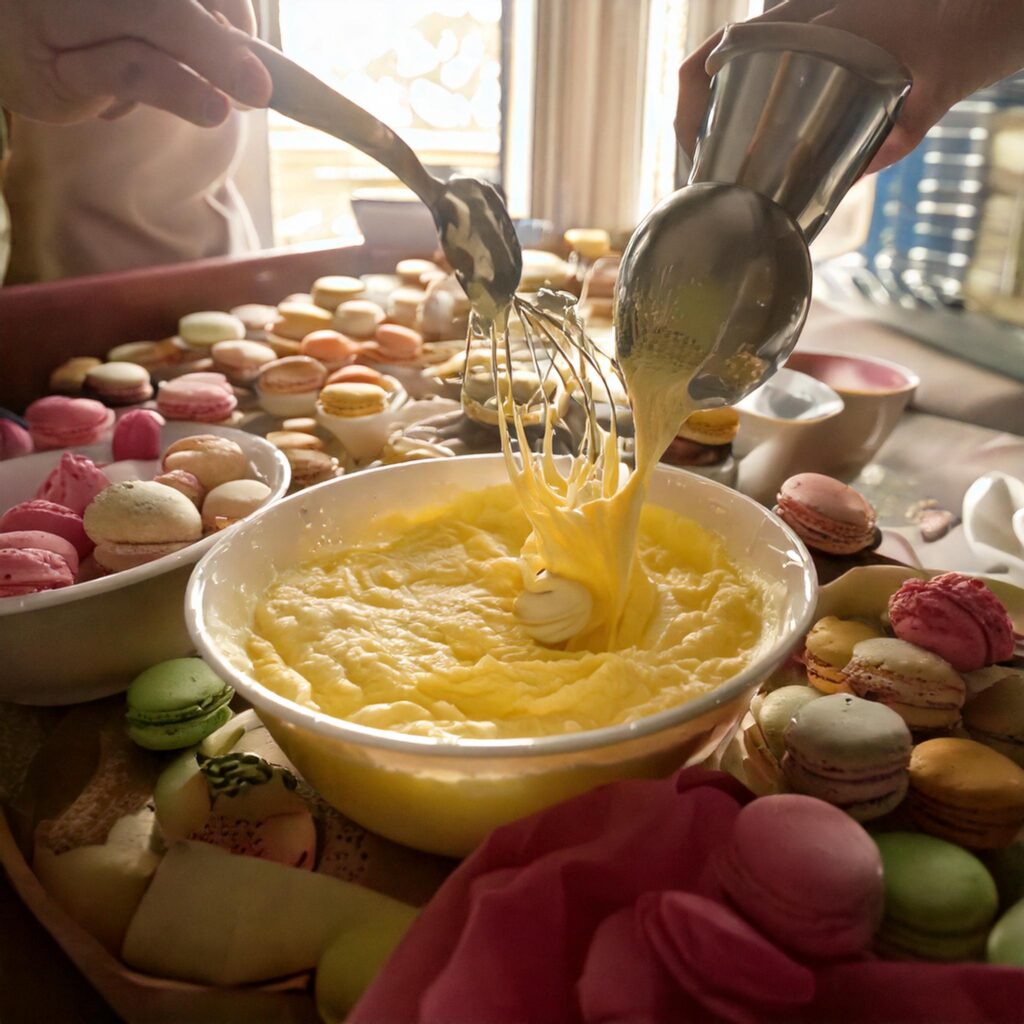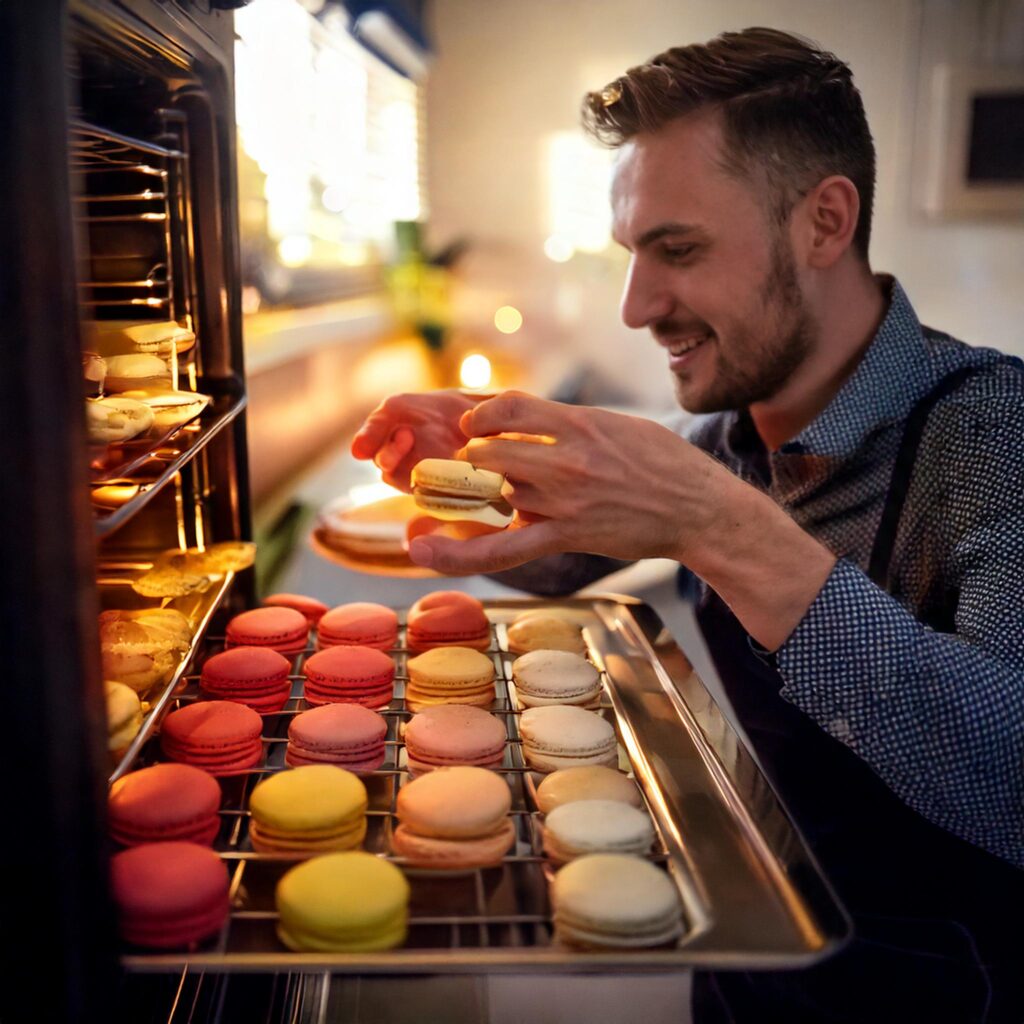Oh boy, where do I even start? Okay, picture this: it’s 2 AM, my kitchen looks like a war zone, and I’m staring at a tray of what can only be described as colourful pancakes. Yep, that was me on my first (okay, maybe third) attempt at making French macarons.
These little cookies are sent straight from the baking gods to test our patience. But after countless failures, a few tears, and maybe a glass of wine or two, I’ve finally cracked the code. Well, most of the time, anyway.
So, grab a cup of coffee, and let’s dive into the wild world of macaron mishaps. Trust me, if I can figure this out, anyone can!
For more fun, check my dessert recipes here.
| Nutritional Value (per 100g): – Calories: Approximately 450 kcal – Carbohydrates: 60g – Sugars: 50g – Fat: 20g – Protein: 6g – Sodium: 50mg Note: Nutritional values can vary based on specific recipes and fillings. Key Ingredients: – Almond Flour: Provides a fine texture and nutty flavor. – Powdered Sugar: Sweetens and stabilizes the meringue. – Egg Whites: Whipped to create the meringue base. – Granulated Sugar: Added to egg whites to form a stable meringue. – Food Coloring: Optional, for desired shell colors. – Fillings: Such as buttercream, ganache, or jam, to sandwich between shells. Preparation Time: – Active Time: Approximately 1 hour – Resting Time: 30 minutes to 2 hours (to form a skin on the shells) – Baking Time: 12-15 minutes per batch |
French macarons Ingredients: The “Close Enough” Trap
Alright, confession time. I was a “eh, close enough” kind of baker. A tablespoon here, a cup there… who needs exact measurements, right? WRONG. So, so wrong.
Let me tell you about the Great Macaron Disaster of 2019. There I was, feeling confident, eyeballing my almond flour like some kind of baking prodigy. Fast forward 30 minutes, and I’m scraping what looks like sad, flat pancakes off my baking sheet. Lesson learned: with french macarons, precision is key.
Here’s what I’ve learned (the hard way):
- Get a digital scale. Seriously, just do it. Your future self will thank you.
- Measure in grams. It’s not just for drug dealers, folks!
- Sift your dry ingredients. Yes, even if the package says “pre-sifted”. Trust no one.
- When in doubt, measure twice. It’s not like you have anything better to do, right?
Remember, baking is edible science. And french macarons? They’re like the demanding, high-maintenance lab experiment of the cookie world.
Macarons Mixing Mayhem: Finding That Goldilocks Consistency
Okay, let’s talk about french macaron. Sounds fancy, right? It’s just a pretentious way of saying “mixing the batter”. But oh boy, is it a doozy.
Picture this: you’re folding the batter, everything’s going great, and you’re feeling like a regular Julia Child. Then you blink, and suddenly, your batter’s turned into soup. I’ve been there, done that, and got the T-shirt.
Here’s my not-so-secret secret for getting it just right:
- Start gently. Treat that batter like it’s a temperamental toddler.
- As it comes together, it gets a bit more aggressive. Show that batter who’s boss!
- Do the figure-8 test. You’re golden if you can draw a figure-8 with the batter without it breaking.
- When in doubt, undermix. You can always mix more, but you can’t unmix!
And hey, if all else fails, just call it “rustic” and pretend you meant to do that.

Weather Woes: When Mother Nature Hates Your french Macarons
So there I was, attempting french macarons on a hot, humid summer day. Spoiler alert: it didn’t end well.
Turns out french macarons are the divas of the baking world. Too humid? They’ll never dry. Too dry? They’ll crack faster than my motivation on a Monday morning.
Here’s how I’ve learned to deal with Mother Nature’s mood swings:
- Aim for a dry day. Or just move to the desert. Whichever’s easier.
- If it’s humid, let those babies rest longer before baking. Like, watch a movie or something.
- In winter, watch out for overly dry air. It’s like the Goldilocks of cookies – everything has to be right.
- Invest in a dehumidifier. Or wave a fan at your french macarons while chanting, “Dry, baby, dry!” (Results may vary.)
Sometimes, it’s okay to admit defeat and make chocolate chip cookies instead. They’re like the reliable friend of the cookie world – always there when you need them.
French Macarons Waiting Game: Why Patience is a Virtue (That I Don’t Have)
Alright, let’s talk about the dreaded resting period. It’s like waiting for paint to dry, except the paint is edible, and you’re hungry.
I’ll admit I’ve tried to skip this step more times than I care to count. The result? Flat, sad little discs that wouldn’t even pass as poker chips. Not my finest moment.
Here’s why resting is crucial (even though it’s torture):
- It forms a skin on top of the shells. It’s quite gross but necessary.
- This skin helps the french macarons rise properly and form those cute little feet. (Yes, we call them feet. Don’t ask.)
- Resting time can vary from 30 minutes to 2 hours. Bring a book. Or a Netflix subscription.
Pro tip: Do the touch test. You’re good to go if you can gently touch the top of a french macaron without it sticking to your finger. If not, well… I hope you’ve got more episodes to watch.
Macarons Oven Drama: When Your Baking Buddy Betrays You

Let me tell you about the time I trusted my oven’s temperature reading. Spoiler alert: it lied—big time.
Most home ovens are about as reliable as a weather forecast. They’ll tell you they’re at 300°F when they’re closer to the sun’s surface temperature.
Here’s how to outsmart your sneaky oven:
- Get an oven thermometer. It’s like a lie detector for your oven.
- Preheat for longer than you think you need to. Like, way longer.
- Find your oven’s hot spots. Every oven has them, like birthmarks, but more annoying.
- If your oven runs hot, adjust the temperature down. And maybe consider a career as a firefighter.
Remember, every oven is unique. It’s like a snowflake but more likely to burn your cookies.
Macarons Baking Surface Blunders: The Great Pan Predicament
Confession time: I once tried to bake macarons on a greased cookie sheet. I know, I know. In my defence, I was young and naive and thought all cookies were created equal.
Spoiler alert: they’re not. The result was a sticky, gooey mess that I may or may not have eaten with a spoon. Hey, no judgment here.
Here’s what I’ve learned about baking surfaces:
- Silicone mats are your friend. They’re like a security blanket for your macarons.
- Parchment paper works, too, but it can wrinkle. And wrinkly french macarons are sad macarons.
- Never, ever use wax paper. Unless you enjoy the smell of burning wax, no judgment. If you do, you do you.
- Those fancy macaron mats with guidelines? They’re great if you fail geometry in school. Not that I’m speaking from experience or anything…
My personal favourite is a good-quality silicone mat. It’s reusable, easy to clean, and doesn’t judge me when I’m on my fifth batch of the day.
The Baking Time Blues for Macarons: When “Golden Brown” Turns to “Charcoal Black”
Finding the perfect baking time is like trying to nail jello to a tree. It’s tricky, frustrating, and likely to end with you covered in something sticky.
I’ve had my fair share of overbaked (hello, hockey pucks) and underbaked (mmm, raw egg white) french macarons. It’s a delicate balance, folks.
Here’s how I’ve learned to achieve that sweet spot:
- Start checking at the minimum baking time. Then check again. And again. Just camp out in front of your oven.
- Do the wiggle test. Gently touch the top of a shell—it shouldn’t wiggle on its feet. If it does, it’s not done. Or it’s doing a little macaron dance. Either way, it goes back in the oven.
- When in doubt, it’s better to slightly overbake than underbake. Unless you’re into salmonella, again, there is no judgment here.
Remember, macarons are like revenge—best served cold or at least completely cooled on the baking sheet.
The Removal Rampage of your Macarons: When Patience Runs Thin
Picture this: your macarons look perfect. They’ve got feet; they’re not cracked; they’re round. It’s a miracle! So naturally, you want to immediately rip them off the baking sheet and shove them in your face, right?
Wrong. Oh, so wrong.
Let me tell you about the Great Macaron Massacre of 2020. In my impatience, I tried to remove still-warm macarons from the baking sheet. The result? A pile of crumbs and broken dreams.
Here’s how to avoid my mistakes:
- Let them cool. Like, completely cool. Do your taxes or something.
- If they stick, pop the whole sheet in the freezer for a few minutes. It’s like cryotherapy for cookies.
- Use a thin spatula to remove the shells gently. Emphasis on gently. This isn’t a strongman competition.
- Transfer to a wire rack. Because apparently, french french macarons are prone to sweaty bottoms. Who knew?
Remember, patience is a virtue. Or so I’m told. I’m still working on that one.
Filling Faux Pas of your Macarons: The Premature Assembly Disaster
I’ll admit it – I’ve been guilty of this one more time than I’d like to count. You’ve got these beautiful shells; all you want to do is slap some filling in there and start munching. I get it; I do.
But let me tell you, filling your macarons too soon is like trying to frost a cake straight out of the oven. It’s just a hot mess. Literally.
Here’s why waiting is worth it:
- Freshly baked shells are still releasing moisture. It’s like they’re going through puberty or something.
- This moisture can make your filling runny and your shells soggy. Nobody likes a soggy bottom; Mary Berry taught us that.
- Waiting allows the flavours to meld. It’s like a little macaron mixer in your fridge.
So, what’s a hungry baker to do? Here’s my tried-and-true method:
- Let the shells cool completely. I mean it this time!
- Prepare your filling and let it cool if necessary. Patience, grasshopper.
- Match up your shells by size. It’s like a delicious game of memory.
- Fill the macarons, then – and this is crucial – refrigerate them overnight.
I know, I know—it seems like torture. But trust me, the difference in texture and flavour is worth it. Your taste buds will eventually thank you.
Ingredient Integrity for your French Macarons: When Cutting Corners Cuts Your Dreams
Listen, I’m all for saving a buck where I can. Dollar store spatula? Sure. Fancy vanilla extract? Eh, maybe not so much.
I learned this the hard way when I tried to make macarons with bargain-bin almond flour. The result? Gritty, lumpy shells that looked more like moon craters than smooth macaron tops—not exactly the elegant French delicacy I was going for.
Here’s where it pays to splurge:
- Almond flour: Go for the good stuff. Your macarons deserve it.
- Egg whites: Fresh is best, but carton whites can work in a pinch. Just don’t tell the French I said that.
- Food colouring: Gel or powder colours are more concentrated. Because nobody wants to eat a pale pink macaron when promised fuchsia.
- Flavouring: Real vanilla extract, not the imitation stuff. Unless you want your macarons to taste like the lies they’re made of.
Remember, you’re making fancy French cookies here, not a box-mix cake. Treat yourself (and your ingredients) with respect!
Wrapping It Up
Whew! We’ve been through a lot together, haven’t we? From measuring mishaps to oven odysseys, we’ve covered the top 10 macaron mistakes and how to avoid them. Or at least how to laugh about them when they inevitably happen.
Remember, even the pros mess up sometimes. I once had a batch turn out looking like tiny hamburger buns. I told everyone they were “avant-garde” macarons. Nobody bought them, but they ate them anyway.
The key is to keep practising. Each batch is an opportunity to perfect your technique. And hey, even if they don’t look Instagram-worthy, they’ll probably still taste pretty good. And if not, that’s what filters are for, right?
So, what are you waiting for? Grab your digital scale, preheat that oven, and get ready to conquer the mighty macaron. And don’t forget to share your triumphs (and hilarious failures) in the comments below. We’re all in this together, after all!
If you’ll excuse me, I’ve got a date with some almond flour and a piping bag. Wish me luck—I’m going to need it!
check out here the nutrition value of the macaron

3 thoughts on “10 Common French Macaron Mistakes and How to Avoid Them”